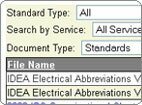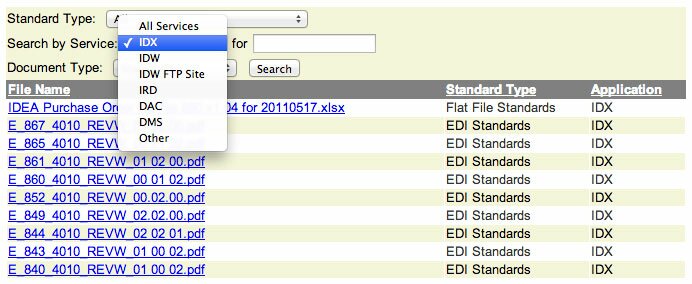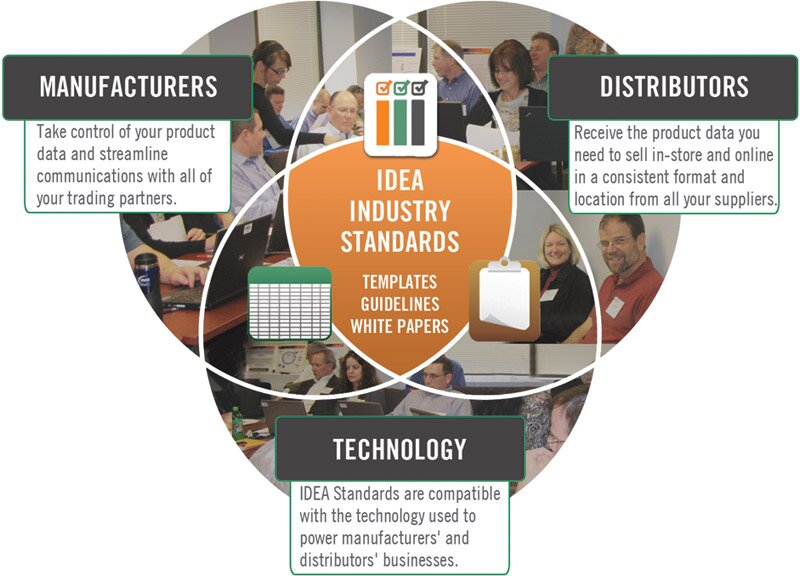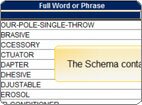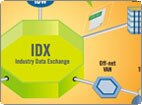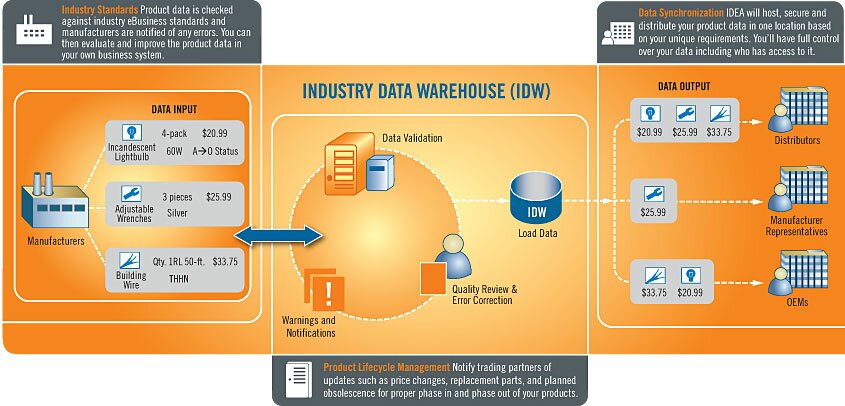
Standards Adoption
eCommerce standards
Standards drive synchronization and synchronization drives efficiency. Dealing with inconsistent product data throughout the supply chain can lead to costly mistakes and slow transaction time. Our solutions are built on a strong standards-based foundation to help trading partners speak one common language.
IDEA is the official eBusiness standards creating and setting body for the electrical industry. We also support the standards developed by national and global standards bodies, such as the American National Standards Institute (ANSI) and GS1 US. The IDEA Industry Standards Committee (ISC) publishes a variety of industry-approved templates, guidelines and white papers which you can use to make communication easier with your trading partners.
Key Benefits:
- Communicate quickly, accurately, and efficiently, in one common language
- Facilitate lights- out operation
- Speed up order-to-cash cycle
Some of the most widely-adopted eBusiness standards we developed and maintain include: the Electrical Attribute Schema, EDIPro Standards, and Net Price Synchronization methods. Click on the tabs to the right to find out more.
The Electrical Attribute Schema is a template based on the global United Nations Standard Products and Services Codes® (UNSPSC®) product categorization system that enables manufacturers to communicate standardized product descriptors (e.g. brand, special features, voltage, wire range, color, etc.) to their trading partners through IDEA’s Industry Data Warehouse (IDW).
IDEA partners with GS1 to develop and maintain the electrical industry UNSPSC® code set to ensure all of your products are represented. There are currently nearly 3,500 product categories represented in the Schema ranging from electrical equipment and lighting to motors, wires and cables.
You can leverage the Schema to reduce errors, increase sales, and build brand loyalty. More benefits:
- Leverage a standardized structure for building intuitive, user-friendly web storefronts
- Promote products accurately and consistently to improve search rankings
- Integrate UNSPSC® codes and their related attributes into business processes to conduct spend analyses and gather market intelligence
- Increase the speed and precision of your product promotions

click to watch schema
training video
EDIPro supports industry best practices in processes such as electronic data interchange (EDI). The guidelines provide a detailed subset of the ANSI X12 specification, one of the largest EDI standards available, and help electrical manufacturers and distributors conduct EDI seamlessly.
Adopting IDEA’s EDIPro guidelines will reduce the time and effort it takes to become EDI-capable, and increase the return from your technology investments. More benefits:
- Integrate electronic processes with business systems, such as Epicor, Infor, Mincron, SAP, and Oracle
- Reduce cost and implementation time – create one EDI map for multiple trading partners
- Import/export product information to IDEA’s Industry Data Warehouse (IDW)
- Automate more business processes with more trading partners – EDIPro is widely adopted in the electrical channel, and adoption is growing in PHCP, PVF, Industrial, and HVAC verticals
IDEA has developed four standardized net price exchange methods for manufacturers to securely send confidential pricing to their trading partners:
- EDI 845 document (most efficient method): a Special Price Authorization document that transmits net pricing information to a trading partner through electronic data interchange (EDI)
- EDI to Flat File translation: a method using the Industry Data Exchange (IDX) to translate a simplified EDI 845 document to a Flat File format that can be sent to trading partners that are not EDI capable
- Simple Net Flat File through the IDW: a Simple Net Flat File is loaded into the Industry Data Warehouse (IDW) for a specific trading partner to extract during a normal download process.
- EDI to the distributor’s IDW FTP folder: a method that uses the IDX to translate a simplified EDI 845 document to a Flat File which is delivered to a trading partner’s IDW FTP folder
By leveraging one of IDEA’s net price exchange methods, you can reduce the time and money spent on data manipulation. More benefits:
- Streamline the invoice-to-payment process
- Make smart business decisions based on accurate inventory value
- Speed up the rebate payment process by reducing manual efforts
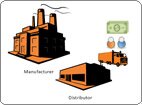
click to watch the net price training video
"IDEA was the first to bring manufacturers and distributors together to make collective decisions. Both parties are literally in same room voicing hardships and pain points and coming up with solutions together. It’s a very collaborative environment and any manufacturer or distributor that is not participating in the conversation is really missing out." — Stacie Braffet, eCommerce Supervisor, IDEAL
"The standardization of data and documents, made possible with the assistance of IDEA, aids in reduction of errors thus lowering the cost of the business transaction. This also helps improve the invoice-to-payment time cycle." — Marilee Anderson, eCommerce Manager, Kirby Risk
"It’s a top down kind of thing; when leaders make it a priority within their company to automate sending and receiving data, then they put the resources in place. It’s important to keep pushing this issue with manufacturers and software vendors, encouraging others to implement the standards and get the software in place to make this happen." — Ron Schlader, VP Operations and Quality, Crescent Electric Supply Co.
"Offering standardized enriched product information is going to make you, as a manufacturer, easier to do business with; it’s going to make your products easier to find, access, and understand. And, in the fast-paced electronic environment that we live and work in today, that could be your only advantage." — Dawn Wright-Perry, Retail Services Manager, Milbank
"We now know that marketing content, enriched descriptions, attributes, and multiple spec documents are becoming global standards. To do business globally, this is what is going to be a necessity. Although the GS1 initiative is mainly being driven by the retail sector, the distribution sector is not far behind. The efforts that NEMA and IDEA are making to incorporate the GS1 understanding of the new attributes is going to put us ahead of the game in the future." — Angela LiVolsi, Data Synchronization Specialist, Philips Lighting Company
"If you place a glue stick vertically on the desk and ask someone for an approximate length, width and height, then place the glue stick horizontally and ask the same question, you get two different interpretations. Similar misinterpretation occurs with electrical product data when there is no industry standard implemented." — Phil Barrios, Senior Director, Corporate Marketing & E-Business, Hubbell, Inc.
"The better the marketing information is on a product, the easier it is to get that product line-up correct. Having standardized attributes makes the whole process from manufacturer to end customer more efficient and reliable." — Jason Archbold, Marketing Supervisor, Business Intelligence, Border States Electric
"I would say that the need for the attributed data and the benefits of that from a manufacturer’s standpoint is to keep our distributors happy. We have a lot of similar products and the only way we can differentiate our products is by using the Electrical Attribute Schema. We’ve seen an increase in accuracy of the data and quantity of the data attributes and our general descriptions have improved." — Peter Vient, Data Sync Coordinator, Osram Sylvania
"It’s all about giving customers a result that’s manageable and you can see by using the Attribute Schema which was developed in conjunction with the all back-fill of all the UNSPC codes, that now when someone comes to one of our sites and wants to use a key word search, we can show them a result set based on every node in our tree, then offer them the balance of the attributes to further define the product. The customer can quickly get down to a set of products to make a buying decision." — David Starr, Corporate Director of eBusiness, McNaughton-McKay


